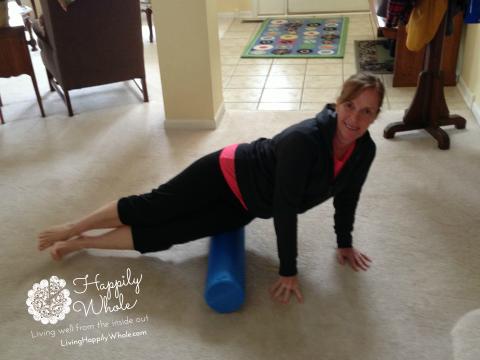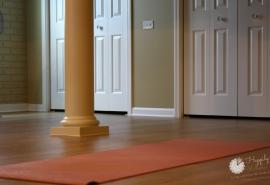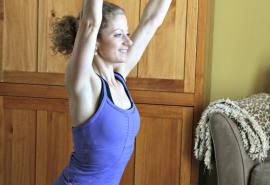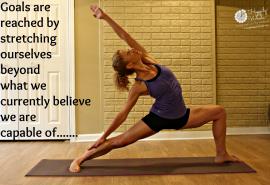
Ugh—sore muscles, tight in spots and no time for a massage. Yep, that’s me! Sometimes I get to the end of a workout and already realize that I am feeling a little sore from something I started with. Not abnormal, right? No, not really, especially if you’re doing something new to you.
Those ‘knots’ may have even been sitting there already, nice and quiet, not making any disturbances or interruptions to your day…until you start stimulating them! The act of exercise, this well-intentioned blessing to our bodies, sometimes points out imbalances, tightness, stiffness and, yep, ‘knots’ tying up our muscles to the point of ‘exercise procrastination’.
No fear, the foam roller is here! What’s a foam roller you ask? Oh, I’m so glad you did! Because now I know that you won’t procrastinate simply because of a silly little ‘knot’, or more professionally labeled, a trigger point.
The What
A foam roller is a wee bit taller than my daughter, about 36″ in length. It’s a large, firm cylinder of foam--hard, unforgiving foam (don’t worry, the pain is temporary…it sorta hurts so good, ya know?). It comes in a variety of firmnesses. Some even have ridges or little spike like bumps in them. Eeks! I have one of those Rumble Rollers and my love-hate relationship with it forced me to pack it away temporarily.
Why would you want to use an unforgiving cylinder of hard foam? Good question. They have a couple different uses for pre and post workout therapy. Therapy? Yep! Pull that baby out for a little self-massage. We see them more and more in Physical Therapy clinics and gyms because studies show massaging sore muscles works wonders to keep muscle tissue healthy. Think of a foam roller as an injury prevention tool. Just as with regular therapeutic massages, the use of a foam roller can actually prevent injury.
The How
Easy peasy! It started in the athletic realm. Think about the acupressure concept: pressure is placed on specific parts of the body. When you roll to apply pressure to sensitive areas in their muscles-sometimes called trigger points, knots, or areas of increased muscle density- you loosen the muscle fibers, which hard-training athletes love. But for you, think about that spot inside your shoulder blades you rub on the corner of your walls or why it feels so good to really give your ‘neck-meat’ (yeah, I coined that term for the meaty part of flesh between your neck and shoulder joint) a good squeeze. The original idea for these foam thingamajigs is to apply pressure to injury-prone areas (and NOT my daughter’s definition that always ends poorly: a moving balance beam).
Gaining in popularity, foam rollers are used by many from accupressure to self-massage. The roller is now usually used to apply longer more sweeping strokes to the long muscle groups like the calves, adductors, and quadriceps, and small directed force to areas like the TFL, hip rotators, and glute medius. Basically, the meaty parts of your legs and bottom.
There is no universal agreement on when to roll, how often to roll, or how long to roll. Sigh! Another fit tip without specific instructions. Frustrating I know, but please remember that fitness is a personal pursuit so you should do what feels right for YOU.
Generally, consider using one before and/or after exercise. Me? I like the after approach. Foam rolling prior to a workout helps decrease muscle density and promote a better warm-up. I’m just not a fan but let me know how you feel! Rolling after a workout may help muscles recover from strenuous exercise more efficiently. Ahh..relief…here’s where I like it. Right after a workout when my muscles are warm and more pliable. I envision my tight muscles opening up from the massage allowing the blood flow back into what were restricted areas. Roll baby roll!
Check out Peggy (love that lady!) using a foam roller on specific trigger points and large muscles.
To roll the hamstring muscle, support your weight with your hands and roll up and down the hamstring.
To roll the piriformus, sit on the roller with weight on one glute (one side of your rumpus). Roll toward that side until you find a trigger point and begin to roll up and down the area.
To roll the iliotibial band (the tight band on the side of your leg running from the knee to the outer hip), place the lower part of your hip on the roller. Support your weight on your hands. Move the roller from the hip to just above the knee.
To roll the quadriceps (big muscle in the front of your upper leg), lay on the roller supported by your forearms. Roll from the crease at the top of your leg to just above your knee.
I fully expect mixed reviews on foam rolling. It’s sorta an acquired taste. But, it really can help loosen tight muscles so definitely worth a try.
Happy Rolling!
Katie






Comments